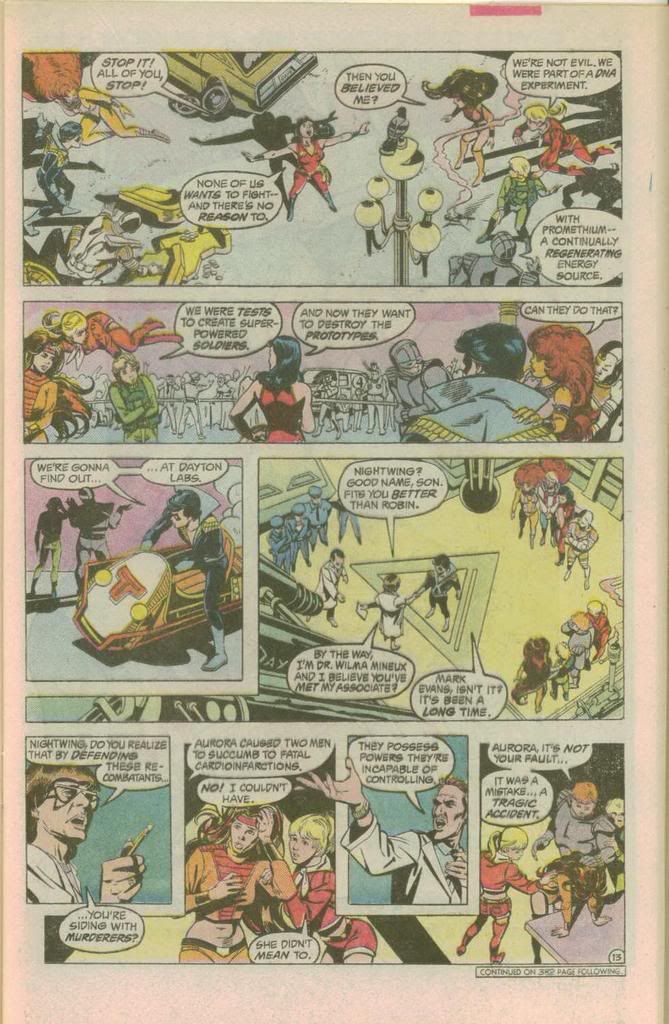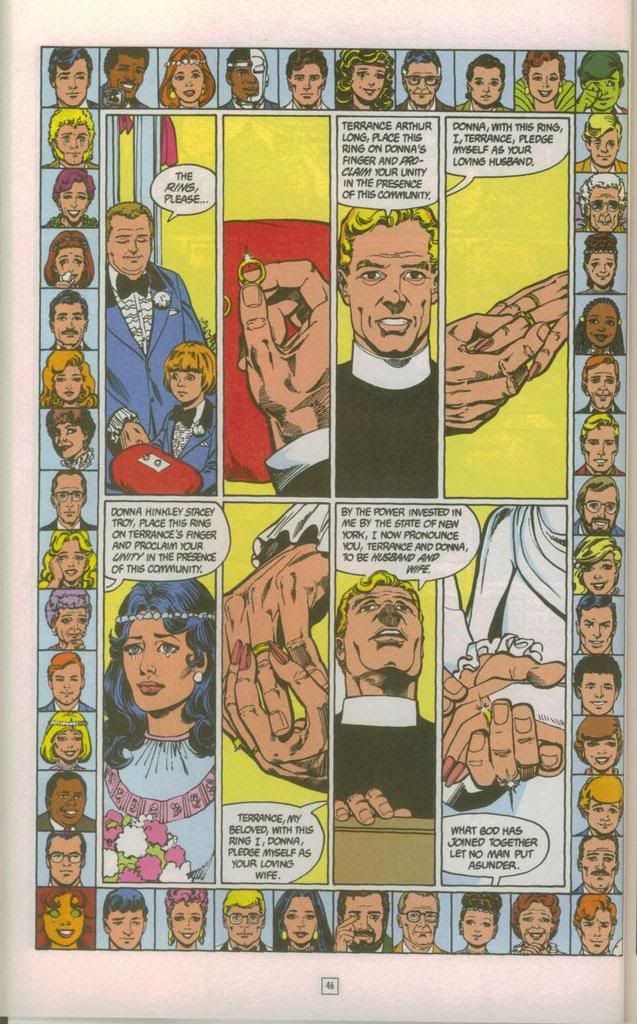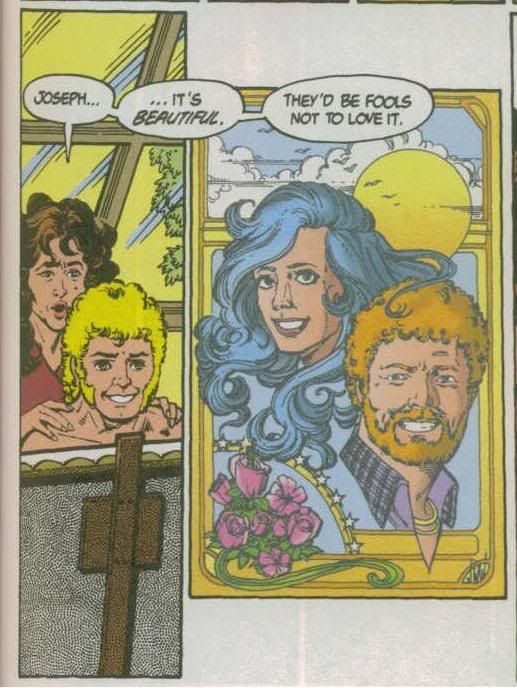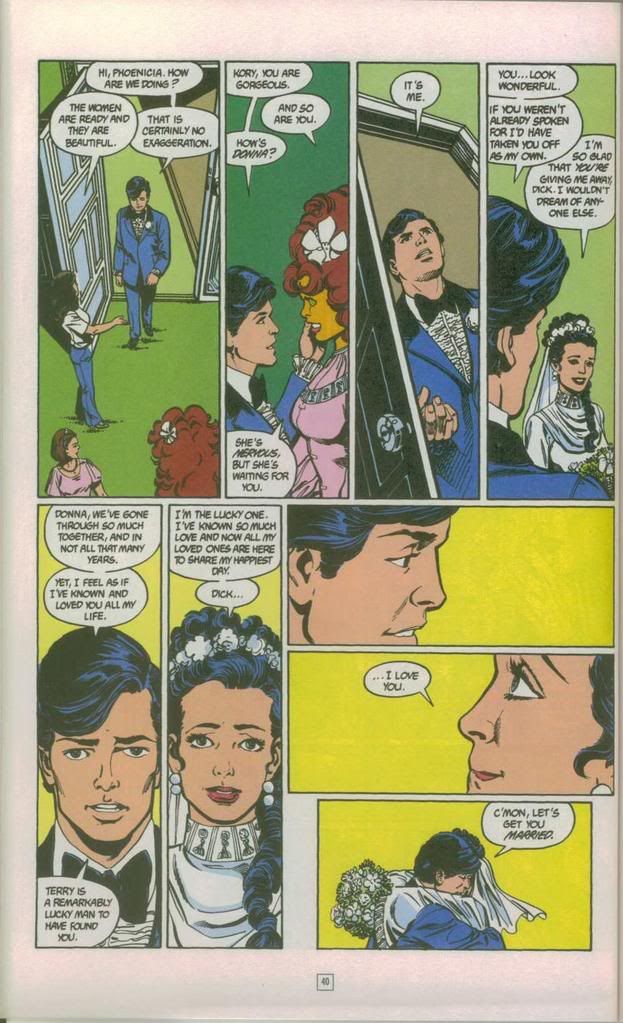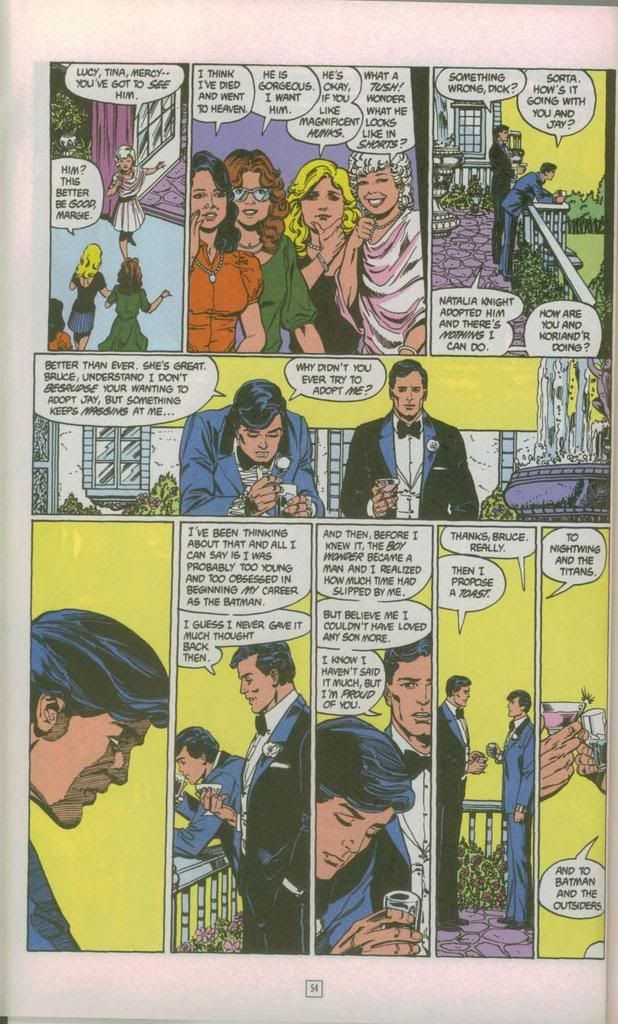The other rather well-worn element of this story was, of course, the Spiritual Elderly African-American Woman, so between those two you'd think this would be a pretty painful issue. However, somehow it actually kind of worked. Probably helped by Merino's inks, Vale's pencils are a good blend of Pacheco and Jerry Ordway. He's probably done a hundred other things I've never heard of, but I liked his work this issue. I tend to pay more attention to the Supes-as-God stories, because I imagine that some people on DC-Earth would have the same reaction our guest star does: he's an actual angel she can command. The bit about "commanding" even makes her a little less spiritual, in the sense that I'm not sure God works like that. Overall it's very reminiscent of Astro City, and a decent AC story is better than a lot of stuff out there.
Wonder Woman #4 (written by Allan Heinberg, pencilled by Terry Dodson, inked by Rachel Dodson) came out this past week, and lucky for it, it doesn't leave much hanging. The big scheduling disaster which has befallen this title wiped out Heinberg concluding this story in #5, but the conclusion looks to be just a big fight scene. The plot is very simple: the "new Wonder Woman" is basically a grim 'n' gritty version, Diana crafts a plan that leaves out a lot of her allies, and there are both stunning reversals and stunning reveals. Well, one of each, at least. I'm sure it will read great in the collection, whenever that appears.
I liked The Spirit #3 (by Darwyn Cooke) well enough, although I found myself instinctively rebelling against shifting first-person narrative captions. Because it's Darwyn Cooke, though, they're handled quite well, and it only takes a split-second to switch between them. It also helps that there's only one narrator per scene. As for the art, Cooke uses looser pencils and a more impressionistic coloring style to distinguish the flashback scenes. I have read the original origin, I think, and this one feels different but it works just fine.
52 #42 (written by JMRW, breakdowns by Keith Giffen, drawn by Darick Robertson) put the spotlight on Ralph Dibny, fighting the Thing Inside Dr. Fate's Helmet. That's not meant as a spoiler, but it's not much of a surprise if you've been paying attention. It's still cool to see Ralph back at the top of his game, and Robertson makes him look both lean and mean. There are a couple of pages with Montoya and her faceless reflection, but other than that it's all Ralph.
Aquaman: Sword Of Atlantis #49 (written by Kurt Busiek, layouts by Mike Manley, inks by Ricardo Villagran) closes out Busiek's revamp with part 2 of the Fisherman story. It's more about the Parasite than it is Aquaman, flashing back to the Fisherman parasite taking over some hapless family man who happened to be down at the docks at the wrong time. I'm not sure if the family-man aspects are more interesting than the present-day guy fighting Aquaman, and it all ends up being a rather creepy tale of shambling horror. Villagran's finishes help feed the horror-story feel.
Checkmate #11 (written by Greg Rucka, Nunzio DeFillippis, & Christina Weir, pencilled by Steve Scott, inked by Nathan Massengill) presents the first part of another trust-no-one story wherein a couple of Checkmate agents are cautioned not to think outside the box and/or take a past familial slight personally, but we know that's practically a flashing neon sign that both those things will happen. However, internal Checkmate politics and the general skill of all involved combine to create a general feeling of unease, like watching a slow-motion train wreck, in a good way. Scott and Massengill provide art that's a little more static than Jesus Saiz, but again that's a good thing. I like this book, and I like reading it month-to-month, because I think I would get either lost or bored trying to get through a paperback. I am dumb.
I am really starting to like the pencils of Nicola Scott, because as presented in Birds Of Prey #103 (written by Gail Simone, inked by Doug Hazlewood), they are very crisp and clean, and they do remind me of Chris Sprouse and Paul Pelletier. Very clean. The story is the untold tale of Barbara Gordon's rival, which unfolds not unlike Lisa Simpson's rival in the episode with Winona Ryder -- the one where Ralph "I bent my Wookiee!" Wiggum wins the diorama contest. Here the stakes are a little higher and there is no Ralph. Instead, Gypsy and Manhunter fight the house supervillains at the jail Manhunter broke into, in a subplot which reminded me of the recent Howard Chaykin/Kilian Plunkett arc in JLA Classified. It was a decent issue, with a couple of well-handled plot twists.
Omega Men #5 (written by Andersen Gabrych, drawn by Henry Flint) was more of the teenage Guardian fighting Lady Styx, with Felicity going through some changes. Everyone else stands around watching these events, and I am right there with them. It's a typical penultimate issue, which means I can't really talk about it right now.
She-Hulk #16 (written by Dan Slott, pencilled by Rick Burchett, inked by Cliff Rathburn) is a big fight against the Wendigo, guest-starring Wolverine, put through the Slott/Burchett wackiness filter. It reminded me of an issue of Peter David's Captain Marvel also (I think) involving the Wendigo and the Hulk, and between that story and this one, there's my knowledge of the Wendigo. He's the Shaggy Man of Marvel, apparently. Some flirtatious banter between Shulkie and Wolvie was jarring to me, but the fights are broken up with funny scenes involving the heroes' backup staffs.
Finally, The Brave and the Bold #1 (written by Mark Waid, pencilled by George Perez, inked by Bob Wiacek) was everything I expected, and that's saying a lot. I like the Batman/Green Lantern pairing generally, and especially if it's Hal Jordan wearing the ring. I also appear to have purchased the alternate cover with Vegas in the background, and I like it better than the promo-art cover I've been seeing a lot more of. Anyway, there's a fight in the Batcave and Roulette shows up towards the end, but in between there's a great setpiece featuring "Wayne ... Bruce Wayne" and his allegedly bumpkin sidekick Hal. Good grief, this is a fun book, and by the way it gives Perez an excuse to dazzle with his layouts and general storytelling ability. Like all of his work, this is a dense issue which invites a Where's Waldo easter-egg hunt. Perez also makes the revisions to Hal's costume work, which I mention only because I think it generally throws off Hal's proportions. I was predisposed to like this book, but the creative team has done some fine work and really exploits the premise very well.

